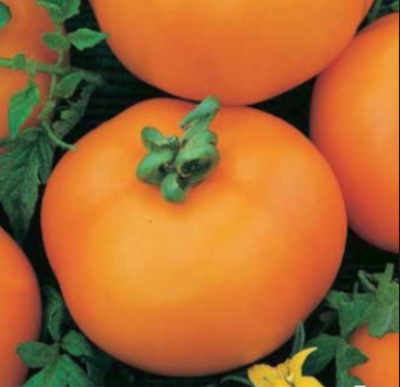
- Category: grade
- Growth type: determinant
- Appointment: fresh consumption
- Ripening period: early
- Ripening time, days: 91-95
- Growing conditions: for open ground
- Marketability: high
- Bush size: undersized
- Bush height, cm: 40-60
- Bush characteristic: compact
Tomato Amber 530 is one of the most popular varieties that farmers and gardeners have worked on to create. The plant attracts gardeners with a generous harvest and resistance to various diseases and pests.
Breeding history
Tomato Yantarny 530 was brought out by specialists from Russia. In 1999, the variety successfully completed the trial and the plant was registered in the register. Today the bush is grown in all regions of the country.
Description of the variety
Tomato Amber 530 is a determinant plant that ripens early enough. The bushes grow low, which allows the crop to start growing immediately. The average height of one bush rarely reaches 40 cm. Features of the culture:
strong stems that do not require a garter;
the formation of 6 fruitful brushes;
high productivity.
When growing tomatoes in greenhouse conditions, it will be possible to harvest several times per season.
The main qualities of the fruit
Tomatoes have an average weight of 120 grams and are flat-round in shape. Other characteristics:
tender pulp;
3-4 seed chambers;
strong skin;
Orange color;
sweet fruity taste.
One bush, subject to the necessary growing conditions, can give two harvests per season.
Taste characteristics
Tomatoes have excellent taste. Juicy pulp, a unique fruity aroma and a high content of vitamins and other nutritional components are the advantages of the hybrid. Tomatoes are good for eating raw and can also be used to make snacks, salads or sauces. The transportation can withstand without any problems.
Ripening and fruiting
Amber tomato ripens quite quickly, literally in 95-100 days, after which it is already possible to harvest the first crop. Fruiting begins 2 weeks after the formation of all 5-6 brushes.
Yield
One square meter of a bush produces from 5 to 7 kg of yield.
The timing of planting seedlings and planting in the ground
A rich harvest directly depends on the quality of planting and care. First of all, you need to take care of the seedlings, and then provide the necessary conditions for planting the seedlings in a permanent place in the garden or greenhouse.
Seedling recommendations:
it is better to plant seeds in boxes or containers with a capacity of up to 2 liters and a depth of 15 cm;
holes should be provided in the container for the withdrawal of excess water;
after picking, the seedlings should be transplanted.
It is better to transfer a tomato to a greenhouse or garden only a month and a half after planting in containers. Basically, the period of transfer of plants falls on the second half of May or early June. By this time, the seedlings have grown by 30 cm.
2-3 weeks before transplanting, the seedlings are hardened. At first, the procedure involves airing the room, after the container they begin to gradually take it out onto the balcony. This approach will speed up the adaptation of the bushes to new conditions.

Growing tomato seedlings is an extremely important process, because it largely depends on whether the gardener will be able to harvest at all. All aspects must be taken into account, from seedbed preparation to planting in the ground.
Landing scheme
The landing procedure is as follows.
Moistened soil is poured into prepared containers.
The seeds are planted to a depth of 1 cm. A distance of 2-3 cm is maintained between the "neighbors".
The containers, covered with foil, are placed in a warm place to accelerate the growth of seedlings. The film is regularly turned over so that condensation does not accumulate inside, which can cause rotting of plants.
When the first shoots appear in the boxes, the tomatoes are harvested on the windowsill and the plant begins to gradually harden. If you wish, you can plant the seeds in peat tablets. In this case, there are 2-3 seeds per tablet. After germination of seedlings, only the strongest seedling is left, removing the rest.

Growing and care
It is better to plant seeds in loose soil, where various fertilizers have been previously applied. When using land from the street, it is recommended to keep it for 2 months at a low temperature, and warm it up before planting seeds.
Other features of growing crops.
Before planting, the seeds are carefully processed to strengthen the immune system, bathing them in potassium permanganate for half an hour. At the end of the procedure, the seeds are washed with warm water.
After planting the crop on the site, you need to take care of regular watering 1-2 times a week so that the soil is always moist. On average, 2 to 3 liters of water should be applied under the bush. Gardeners recommend paying special attention to the variety during the flowering period. When the bushes begin to bear fruit, watering is reduced as much as possible and only warm water that has been settled in advance is used.
For better absorption of moisture by the earth, it is loosened. When the number of irrigations is reduced, the soil is mulched with humus or straw.
Recommendations for the introduction of dressings.
In spring, it is better to fertilize tomatoes with slurry or fertilizers, which contain nitrogen, to accelerate the growth of shoots and leaves.
During flowering, it is better to add fertilizing with phosphorus and potassium, wood ash to the soil.
Tomato Amber 530, with careful care, regular watering and feeding, will delight you with a generous harvest.




A plant needs different micronutrients at each stage of growth. All fertilizers can be divided into two groups: mineral and organic. Folk remedies are often used: iodine, yeast, bird droppings, eggshells.
It is important to observe the rate and period of feeding. This also applies to folk remedies and organic fertilizers.



























































































